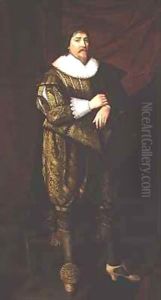Abraham van Blijenberch Paintings
Abraham van Blijenberch was a Flemish portrait painter, active in the late 16th and early 17th centuries. Although the exact date of his birth is not known, it is believed that he was born around 1575. Little is known about his early life and training, but he is thought to have been active in Antwerp and possibly had connections with the prominent artists of the time, such as Peter Paul Rubens.
Van Blijenberch is known for his portrait work, and he became particularly well-regarded for his ability to capture the likeness and character of his sitters. His paintings are characterized by their detailed rendering of clothing and fabrics, as well as the dignified representation of his subjects. He was skilled in the use of light and shadow to create depth and volume in his portraits.
One of the most notable aspects of Van Blijenberch's career was his connection to the English court. He traveled to England in the early 17th century, where he painted portraits of several members of the aristocracy, including the famous portrait of the poet Ben Jonson, which is now held in the National Portrait Gallery in London. This period of his work is particularly significant as it provides a visual record of notable figures from the Jacobean era.
Despite his success as a portraitist, there are relatively few surviving works definitively attributed to Van Blijenberch. His death is recorded in 1624, and by that time, he had made a significant contribution to the art of portraiture. His work is an important part of the cultural exchange between the Low Countries and England during the period and offers valuable insights into the fashion and society of his time. Today, his portraits are considered important historical documents as well as artistic achievements.
